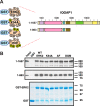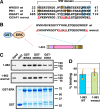The WW domain of the scaffolding protein IQGAP1 is neither necessary nor sufficient for binding to the MAPKs ERK1 and ERK2
- PMID: 28396345
- PMCID: PMC5448102
- DOI: 10.1074/jbc.M116.767087
The WW domain of the scaffolding protein IQGAP1 is neither necessary nor sufficient for binding to the MAPKs ERK1 and ERK2
Abstract
Mitogen-activated protein kinase (MAPK) scaffold proteins, such as IQ motif containing GTPase activating protein 1 (IQGAP1), are promising targets for novel therapies against cancer and other diseases. Such approaches require accurate information about which domains on the scaffold protein bind to the kinases in the MAPK cascade. Results from previous studies have suggested that the WW domain of IQGAP1 binds to the cancer-associated MAPKs ERK1 and ERK2, and that this domain might thus offer a new tool to selectively inhibit MAPK activation in cancer cells. The goal of this work was therefore to critically evaluate which IQGAP1 domains bind to ERK1/2. Here, using quantitative in vitro binding assays, we show that the IQ domain of IQGAP1 is both necessary and sufficient for binding to ERK1 and ERK2, as well as to the MAPK kinases MEK1 and MEK2. Furthermore, we show that the WW domain is not required for ERK-IQGAP1 binding, and contributes little or no binding energy to this interaction, challenging previous models of how WW-based peptides might inhibit tumorigenesis. Finally, we show that the ERK2-IQGAP1 interaction does not require ERK2 phosphorylation or catalytic activity and does not involve known docking recruitment sites on ERK2, and we obtain an estimate of the dissociation constant (Kd ) for this interaction of 8 μm These results prompt a re-evaluation of published findings and a refined model of IQGAP scaffolding.
Keywords: IQGAP1; cancer; cell signaling; extracellular-signal-regulated kinase (ERK); mitogen-activated protein kinase (MAPK); protein complex; protein kinase; protein-protein interaction; scaffold protein.
© 2017 by The American Society for Biochemistry and Molecular Biology, Inc.
Conflict of interest statement
The authors declare that they have no conflicts of interest with the contents of this article
Figures






Similar articles
-
IQGAP1 is a scaffold for mitogen-activated protein kinase signaling.Mol Cell Biol. 2005 Sep;25(18):7940-52. doi: 10.1128/MCB.25.18.7940-7952.2005. Mol Cell Biol. 2005. PMID: 16135787 Free PMC article.
-
IQGAP1 regulates ERK1/2 and AKT signalling in the heart and sustains functional remodelling upon pressure overload.Cardiovasc Res. 2011 Aug 1;91(3):456-64. doi: 10.1093/cvr/cvr103. Epub 2011 Apr 14. Cardiovasc Res. 2011. PMID: 21493702 Free PMC article.
-
IQGAP1 scaffold-kinase interaction blockade selectively targets RAS-MAP kinase-driven tumors.Nat Med. 2013 May;19(5):626-630. doi: 10.1038/nm.3165. Epub 2013 Apr 21. Nat Med. 2013. PMID: 23603816 Free PMC article.
-
MAP kinase: it's been longer than fifteen minutes.Biochem Biophys Res Commun. 2008 Jun 20;371(1):1-4. doi: 10.1016/j.bbrc.2008.04.002. Epub 2008 Apr 10. Biochem Biophys Res Commun. 2008. PMID: 18406346 Review.
-
ERK1/2 MAP kinases: structure, function, and regulation.Pharmacol Res. 2012 Aug;66(2):105-43. doi: 10.1016/j.phrs.2012.04.005. Epub 2012 Apr 27. Pharmacol Res. 2012. PMID: 22569528 Review.
Cited by
-
Role of IQGAP1 in Carcinogenesis.Cancers (Basel). 2021 Aug 4;13(16):3940. doi: 10.3390/cancers13163940. Cancers (Basel). 2021. PMID: 34439095 Free PMC article. Review.
-
Ubiquitination of the scaffold protein IQGAP1 diminishes its interaction with and activation of the Rho GTPase CDC42.J Biol Chem. 2020 Apr 10;295(15):4822-4835. doi: 10.1074/jbc.RA119.011491. Epub 2020 Feb 24. J Biol Chem. 2020. PMID: 32094223 Free PMC article.
-
IQGAP1 Maintains Pancreatic Ductal Adenocarcinoma Clonogenic Growth and Metastasis.Pancreas. 2019 Jan;48(1):94-98. doi: 10.1097/MPA.0000000000001198. Pancreas. 2019. PMID: 30540680 Free PMC article.
-
Role of IQ Motif-Containing GTPase-Activating Proteins in Hepatocellular Carcinoma.Front Oncol. 2022 Jun 16;12:920652. doi: 10.3389/fonc.2022.920652. eCollection 2022. Front Oncol. 2022. PMID: 35785216 Free PMC article. Review.
-
The Specificity of EGF-Stimulated IQGAP1 Scaffold Towards the PI3K-Akt Pathway is Defined by the IQ3 motif.Sci Rep. 2019 Jun 24;9(1):9126. doi: 10.1038/s41598-019-45671-5. Sci Rep. 2019. PMID: 31235839 Free PMC article.
References
-
- Dhillon A. S., Hagan S., Rath O., and Kolch W. (2007) MAP kinase signalling pathways in cancer. Oncogene 26, 3279–3290 - PubMed
-
- Lawrence M. C., Jivan A., Shao C., Duan L., Goad D., Zaganjor E., Osborne J., McGlynn K., Stippec S., Earnest S., Chen W., and Cobb M. H. (2008) The roles of MAPKs in disease. Cell Res. 18, 436–442 - PubMed
-
- Caunt C. J., Sale M. J., Smith P. D., and Cook S. J. (2015) MEK1 and MEK2 inhibitors and cancer therapy: the long and winding road. Nat. Rev. Cancer 15, 577–592 - PubMed
-
- Lito P., Rosen N., and Solit D. B. (2013) Tumor adaptation and resistance to RAF inhibitors. Nat. Med. 19, 1401–1409 - PubMed
-
- Dhanasekaran D. N., Kashef K., Lee C. M., Xu H., and Reddy E. P. (2007) Scaffold proteins of MAP-kinase modules. Oncogene 26, 3185–3202 - PubMed
Publication types
MeSH terms
Substances
Grants and funding
LinkOut - more resources
Full Text Sources
Other Literature Sources
Research Materials
Miscellaneous

